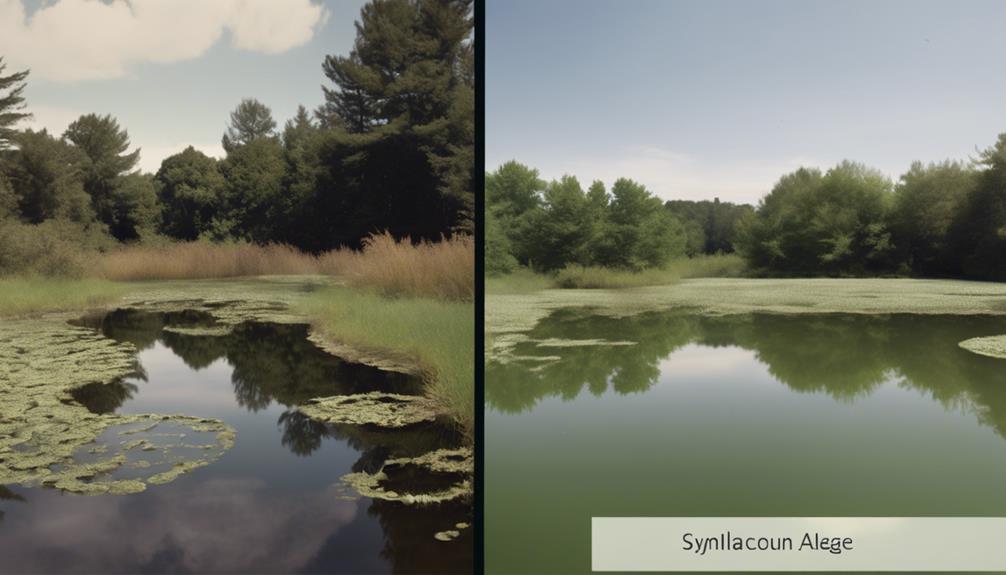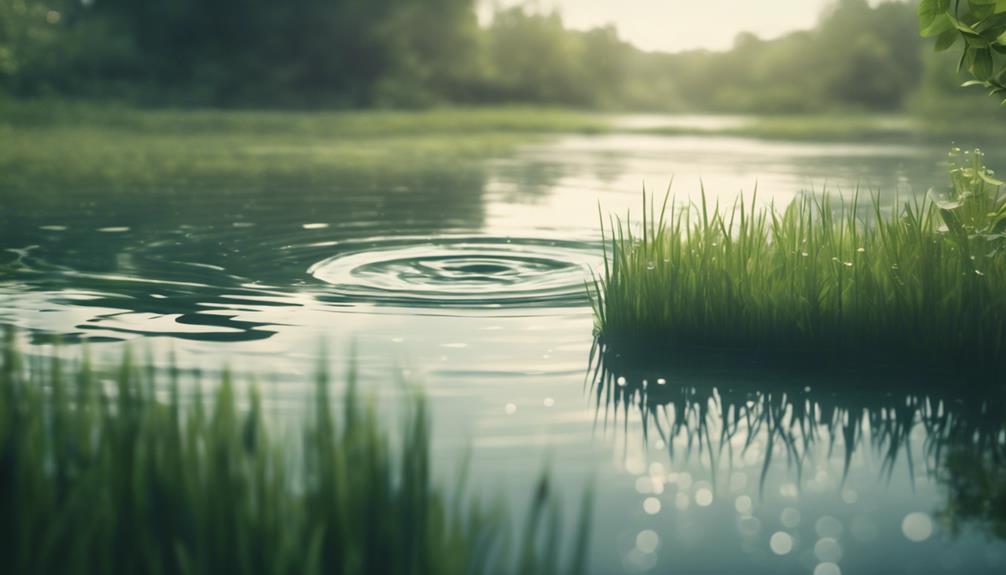To circulate water efficiently, you need a well-designed aeration system that increases oxygen levels and maintains a healthy ecosystem. Accurate system sizing and design guarantee effective circulation of water and air. Installation during late fall through early spring prevents man-made turnovers. Consistent operation schedules prevent stratification and low oxygen conditions. Regular oxygen level monitoring is vital, especially during early morning hours. You'll want to test oxygen levels regularly to maintain a healthy and thriving pond ecosystem. By following these essential aeration tips, you'll be well on your way to creating a balanced and resilient aquatic environment – and there's even more to explore.
Table of Contents
Key Takeaways
- Accurate sizing and designing of the aeration system guarantees effective circulation of water and air in the pond or lake.
- Diffusion systems are the most efficient way to circulate water, especially in larger bodies of water, to promote healthy oxygen levels.
- Aeration is best done in the fall for cool-season grasses and in the spring or summer for warm-season grasses to optimize benefits.
- Centrifugal irrigation pumps can be used with correct design, but they require frequent maintenance to ensure efficient water circulation.
- Regular oxygen level monitoring is crucial, especially during early morning hours when levels are typically at their lowest, to prevent oxygen depletion.
Understanding Aeration Importance
When it comes to lawn care, you need to understand that aeration plays a pivotal role in maintaining a healthy, thriving landscape.
Lawn aeration is a process that involves removing small plugs of soil and grass to improve air, water, and nutrient circulation.
This process is essential for improving soil structure, reducing soil compaction, and promoting overall health.
Core aeration, in particular, is an effective way to alleviate soil compaction, which can prevent water and air from penetrating the soil.
By allowing water to reach the roots, you'll notice significant improvements in your lawn's appearance and resilience.
During the aeration process, you're creating pathways for water, air, and nutrients to reach the roots, resulting in a more robust and vibrant lawn.
By incorporating regular aeration into your lawn care routine, you'll be rewarded with a lush, green landscape that's better equipped to withstand environmental stresses.
Choosing the Right System
With numerous aeration systems available, you'll need to select the one that best suits your lawn's specific needs and your personal preferences.
Aeration is vital for maintaining a healthy lawn, as it allows water and nutrients to penetrate the soil more easily. To aerate my lawn effectively, you'll want to choose a system that can create small holes in the soil, allowing air, water, and nutrients to reach the roots.
When selecting an aeration system, consider the ideal time for lawn maintenance. For cool-season grasses, aeration is best done in the fall, while warm-season grasses benefit from spring or summer aeration.
Additionally, consider the type of soil you have, as some systems are better suited for clay, sandy, or loamy soils. Finally, think about your budget and the size of your lawn, as some systems may be more cost-effective for smaller lawns.
Sizing and Designing Correctly

You'll need to accurately size and design your aeration system to guarantee it effectively circulates water and air throughout your lawn.
To achieve this, consider diffusion systems, which are the most efficient way to circulate water.
When sizing your system, factor in the surface area, depth, and shape of the pond. Shallow ponds, for instance, may require more diffusers due to reduced bubble travel distance, while ponds with odd shapes or narrow canals may need multiple diffusers.
Centrifugal irrigation pumps can be used with correct design, but keep in mind they require frequent maintenance and are less efficient.
Avoid using fountains, which are the least efficient way to circulate ponds and are often used for aesthetic reasons rather than water circulation.
Preventing Turnovers and Fish Kills
Properly installed and maintained aeration systems can substantially reduce the risk of turnovers and fish kills by increasing oxygen levels and stabilizing water temperatures.
As a responsible pond owner, you want to provide a healthy environment for your fish and other aquatic life. Turnovers occur when the water's thermal layers mix, causing a rapid change in water temperature and oxygen levels, which can be deadly for fish.
Aeration helps prevent this by circulating water efficiently and increasing oxygen levels. Additionally, aeration promotes a balanced ecosystem by supporting the growth of forage, a crucial food source for your fish.
By preventing turnovers, you'll reduce the risk of fish kills and create a thriving pond ecosystem. To further minimize the risk of turnovers, guarantee your pond's water temperature is stable, and avoid sudden changes in water chemistry.
Installation and Start-Up Tips

When installing an aeration system, timing is everything, and choosing the right season can make all the difference in minimizing disruptions to your pond's ecosystem. You'll want to aim for late fall through early spring, ideally in April, to avoid disturbing the aquatic life.
Installing during warm summer months can cause man-made turnovers, so it's vital to avoid this timeframe.
During start-up, it's key to take it slow and steady. Start the system in short increments, such as 10 minutes per day, over the first two weeks to prevent shocking the pond's ecosystem.
You should also test oxygen levels during this period to verify the system is functioning properly and not causing harm to aquatic life.
Consult with the system manufacturer for specific start-up recommendations, as different systems may have unique requirements.
Monitor oxygen levels closely to verify the system is working correctly.
Be patient and avoid rushing the start-up process to prevent ecosystem disruptions.
Operating and Maintaining Systems
By following a consistent operation schedule, you can guarantee your aeration system effectively prevents stratification and low oxygen conditions, maintaining a healthy aquatic ecosystem.
To achieve this, it's essential to operate your circulation system continuously, especially during warm summer months when oxygen levels are at their lowest.
During start-up, test oxygen levels regularly to confirm the system is performing at its peak. Initially, run the system in short increments (10 minutes per day) over the first two weeks to prevent shocking the aquatic ecosystem. As the system becomes more efficient, you can gradually increase operating time.
During fall and winter (November to March), you can turn off the system, as ponds naturally destratify during this period. However, maintaining a consistent operation schedule is necessary to prevent low oxygen conditions.
Managing Nutrient Inflows Effectively

You can substantially mitigate oxygen depletion and water quality issues in your pond by controlling nutrient-rich runoff from surrounding areas.
Excessive nutrients can lead to aquatic plant growth, which can further exacerbate oxygen depletion and water quality problems.
By implementing best practices for reducing nutrients in runoff, you can prevent low oxygen conditions and maintain a healthy ecosystem.
Some key strategies to ponder:
Maintain vegetative buffers around your pond to absorb excess nutrients
Use sedimentation ponds to capture and remove nutrients from runoff
Regularly test water quality and nutrient levels to identify potential issues before they become severe
Dealing With Common Challenges
Even with effective nutrient management strategies in place, pond owners still face various challenges that can disrupt water quality and oxygen levels, requiring proactive measures to address these issues.
You might experience an overabundance of water and nutrients, particularly during early summer and early fall, which can lead to excessive algae growth and depleted oxygen levels.
Aeration can help mitigate these issues by increasing water circulation and allowing air to penetrate deeper into the water column.
Another common challenge is soil erosion, which can be addressed by using soil plugs to improve soil stability and prevent sedimentation.
By doing so, you can reduce the amount of nutrients entering your pond and create a more balanced ecosystem.
Additionally, aeration can help break down organic matter and reduce the buildup of sediment, further improving water quality.
By being proactive and addressing these common challenges, you can maintain a healthy and thriving pond ecosystem.
Monitoring Oxygen Levels Regularly

When it comes to monitoring oxygen levels regularly, you'll want to make it a habit to check oxygen levels frequently, especially during early morning hours when they're typically at their lowest.
By doing so, you'll be able to identify potential issues early on and take corrective action before they become major problems.
Regular oxygen level checks will provide you with valuable insights into your pond's health, allowing you to respond quickly to early warning signs.
Oxygen Level Checks
Regular monitoring of oxygen levels is crucial to detect early signs of oxygen depletion, which can have devastating consequences for your aquatic ecosystem.
As the guardian of your pond's health, it's imperative to stay on top of oxygen levels to prevent fish kills and other imbalances.
When checking oxygen levels, remember to:
Take readings at different depths and locations, as oxygen concentrations can vary markedly between surface and bottom waters.
Use a dissolved oxygen meter to get accurate readings, aiming for ideal levels between 5-15 parts per million (ppm) depending on your aquatic ecosystem.
Monitor oxygen levels during extreme weather conditions, such as heatwaves or turnover events, to prevent sudden and catastrophic oxygen depletion.
Regular Water Testing
By making oxygen level checks a routine part of your pond management strategy, you'll be able to catch potential problems before they escalate into full-blown crises, and regular water testing is a key component of this proactive approach.
To guarantee accurate readings, use a dissolved oxygen meter or test kit to measure oxygen levels, aiming for above 5 ppm for healthy aquatic life. This is crucial to test the water at least once a week, especially during warm weather or when algae blooms are present, as oxygen levels can fluctuate rapidly.
Testing oxygen levels at different depths and locations within the pond or lake provides a more thorough understanding of water circulation and aeration efficiency.
Regular water testing also allows you to track changes in oxygen levels over time, enabling data-driven decisions about aeration system adjustments or other water management strategies.
Early Warning Signs
Monitoring oxygen levels regularly allows you to catch early warning signs of potential problems, such as sudden dips in oxygen levels or inconsistent readings across different depths and locations.
As a lawn care professional, it's vital to stay on top of oxygen levels to prevent dead grass and stunted root growth. When oxygen levels drop, it can hinder nutrient uptake, leading to a decline in overall lawn health.
Inconsistent oxygen readings across different depths and locations are a key indicator to watch out for.
Sudden dips in oxygen levels, especially during peak growing seasons, can be a cause for concern.
Changes in soil core samples, such as increased soil compaction or reduced pore space, can also signal potential oxygen-related issues.
Adjusting for Seasonal Changes
As you adapt your aeration system to seasonal changes, you'll need to tweak the timing and frequency of aeration to accommodate shifting water temperatures and oxygen demand. In late spring, your lawn needs aeration the most, as it's entering its growth phase. This is the best time to aerate, as it allows your lawn to absorb water and nutrients more efficiently, leading to a lush lawn.
To optimize your aeration system, consider the following adjustments:
| Season | Aeration Frequency |
|---|---|
| Late Spring | Increase frequency to 2-3 times a week |
| Summer | Maintain frequency, but reduce duration |
| Early Fall | Decrease frequency to 1-2 times a week |
| Late Fall | Reduce frequency to once a month |
| Winter | Suspend aeration, as water temperatures are too low |
Frequently Asked Questions
What Is the Best Way to Aerate Water?
As you pursue for peak water quality, you'll find the best way to aerate water is by selecting the right aeration method, considering oxygen levels, water flow, tank size, and bubble size to guarantee efficient aeration systems.
How Can You Increase the Efficiency of Aeration of Water?
Imagine a 5-acre pond with a well-designed aeration system, ensuring efficient water flow and ideal oxygen levels. You can increase aeration efficiency by selecting the right pump, maintaining the system, and ensuring even bubble distribution, resulting in energy savings and a healthy ecosystem.
What Is the Best Method of Aeration in Water Treatment?
You'll find that diffusion-based aeration systems are the best method for water treatment, as they optimize water quality by increasing oxygen levels through efficient bubble formation, while minimizing energy consumption and turbulence creation.
What Is the Best Practice for Lawn Aeration?
When you neglect lawn aeration, it's like not stretching before a workout – you'll suffer later. Proper lawn preparation, considering soil structure, aeration timing, and soil type, guarantees core removal and sets you up for successful turf management and a healthy, thriving lawn.
Conclusion
Efficient water circulation is vital for a thriving aquatic ecosystem.
To illustrate, consider a 10-acre lake in Wisconsin that implemented a well-designed aeration system, resulting in a 30% increase in dissolved oxygen levels and a 25% reduction in algae blooms.
By following these 10 essential aeration tips, you can achieve similar success and create a healthy, balanced environment for your aquatic life to flourish.

